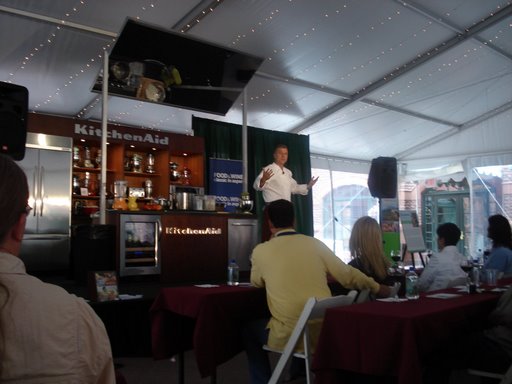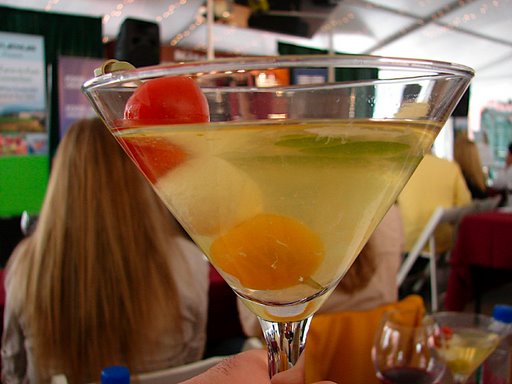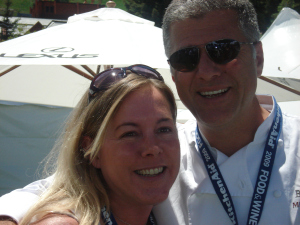On day 2 of the Food & Wine Classic in Aspen I attended the Lexus talk “The Farm to Fork Connection: Creating a Sustainable World at Your Table” featuring Top Chef Master Michael Chiarello and master organic gardener Peter Jacobsen.
Peter Jacobsen, who calls his work “tantric farming” began the talk discussing food as an agricultural act. He requested that everyone become a farmer of sorts, and suggested planting basil, in order to understand and become involved in the agricultural process. He also suggested “voting with your fork”, making your economic decisions on which restaurant to dine in, ask questions, and find out if your venue is using local and sustainable food.
 Chef Michael Chiarello, cheerfully admitting to having a slight red wine hangover, took the stage next. He talked about the process of taking over a piece of land that had previously been a non organic chemical farm, and transforming the land into organic, and watching the process over 7-8 years as the plot developed a new life and an entirely new ecosystem. He now has several new quail on the previously barren land, as well as cattails, frogs and ducks.
Chef Michael Chiarello, cheerfully admitting to having a slight red wine hangover, took the stage next. He talked about the process of taking over a piece of land that had previously been a non organic chemical farm, and transforming the land into organic, and watching the process over 7-8 years as the plot developed a new life and an entirely new ecosystem. He now has several new quail on the previously barren land, as well as cattails, frogs and ducks.
Michael discussed how grocery store produce, and even organic produce from places such as Trader Joe’s , create a huge carbon footprint with gas and transportation, with the added insult of bringing in goods from hundreds of miles away. He stated that his goal with his restaurants is to have every food item come from within a 100 mile radius.
During a question and answer session, I asked him a tricky question which I have always been perplexed by. When given the choice to choose between local (non certified organic) and non local certified organic, what should we do? Chef Chiarello said to always choose local. He touched base on the fact that some farmers do not use chemicals however do not have the resources to become “certified organic”. He went on to say when you know the farmer that you are buying from, (and used a tomato as an example) you will respect the tomato and will not let it go to waste. He stressed that having a connection with the local people your food comes from will ultimately affect the flavor and the overall tasting experience as a result of the connectivity. “Having a relationship with your food is one of the most important things you can do”. I truly love this concept, and have been musing over it ever since.
(At this point I immediately had a flashback to the Thursday night Tapas party. The roasted lamb was prepared, seasoned, and nurtured by Jacques Pepin and Jose Andres, and sliced with master skill by Jose Andres. Sliced morsels were fed by hand, from Jose, directly into several Top Chef winner’s mouths. I apologize for not capturing this on film! The sight was slightly sensual to say the least, and while not completely spot on with Michael’s points, still a delicious example of connectivity and food).
During the talk Michael made a basil infused olive oil (recipe here), and added a touch of it to an amazing pureed and strained tomato water martini (sans alcohol, recipe below) with homemade mozzarella boccacini and cherry tomatoes. Jen from the Daily Blender, Sara from Average Betty, Chef John from Foodwishes and I have been craving more of it all day long. Cheers and thank you so much Peter and Michael for enlightening us with your knowledge!

©foodwishes.com
Chef Michael Chiarello’s Tomato Martini
* 3 cups clear tomato water, set aside from Tomato Puree, recipe follows, refrigerated
* 1 green zebra tomato, thinly sliced
* 4 fresh mozzarella boccacini, each 1-inch in diameter
* 4 cherry tomatoes
* Gray salt and freshly ground black pepper
* 8 large fresh basil leaves
* Basil oil, optional (recipe link above martini photo)
Directions
You will need enough tomato water to fill your martini glasses, so measure their capacity, probably something between 5 and 9 ounces. Chill the martini glasses in the freezer, if there is room, or refrigerate 1 hour ahead of serving. (A freezer gives a heavy frost.)
Place 1 slice of green tomato in each glass. Halve or quarter the bocconcini if they are larger than 1 inch in diameter. Thread a bocconccini, and a cherry tomato onto each of 4 wooden skewers 4 to 5 inches long. Season with salt and pepper and drizzle with basil oil, if desired. Working quickly, divide the tomato liquid among the chilled martini glasses. Balance the skewers on top of the glasses, then take a leaf of basil per glass, and rub it around the glass rim, before placing on top of each glass, near skewer. Serve immediately.
*Cook’s Note: It is impossible to give a specific amount for the tomatoes because how much “water” a tomato releases depends on many factors, including the growing season and the variety. Do not let the tomato pulp go to waste. Use this recipe as an excuse to start your quick tomato sauce season. You can freeze or can your sauce and then have it on hand for quick meals.
Tomato Puree:
20 tomatoes, core removed
Bring 2 large pots of water to a boil. Lower the tomatoes into the water, blanch for 45 seconds to 1 minute. Place blanched tomatoes on a baking sheet, and peel the loosened skins. With a colander over a bowl, squeeze the seeds and innards out of each tomato. Set aside and refrigerate the clear strained liquid for other uses. Slice the peeled tomatoes into 1-inch chunks, and place chunks into blender. Puree thoroughly. Pour into bowl.
Recipe makes 10 to 12 cups.




